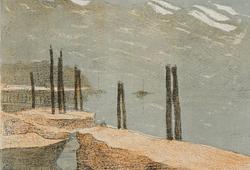Helene Schjerfbeck
"Självporträtt" (Self portrait)
Signed HS. Executed 1944. Charcoal on paper 20.5 x 18.5 cm.
Alkuperä - Provenienssi
Gösta Stenman, Stockholm.
Galleri Axlund, Stockholm.
Ingemar Dahlberg Collection, Stockholm.
Näyttelyt
Musée d'Art Moderne de la Ville de Paris, "Visions du Nord", 1988.
Göteborgs konstmuseum, "Helene Schjerfbeck - teckningar och akvareller", 11 May - 28 August 1994.
Sundsvalls Museum, "Helene Schjerfbeck - teckningar och akvareller", 3 December 1994 - 8 January 1995.
Amos Anderssons konstmuseum, "Helene Schjerfbeck - teckningar och akvareller", Helsingfors, 28 January - 2 April 1995.
Kirjallisuus
H. Ahtela, "Helena Schjerfbeck", 1953, listed in the catalogue as no 951, p 371.
Lena Holger, "Helene Schjerfbeck - teckningar och akvareller", 1994, illustrated and essay about the work p 92.
(red) Leena Ahtola-Moorhouse, "Helene Schjerfbeck 150 år", utställningskatalog, Statens konstmuseum Ateneum, Helsingfors, 2012, illustrated p 340 (cat no 697).
Muut tiedot
The following essay was part of the exhibition catalogue for “Helene Schjerfbeck – drawings and watercolours” and Bukowskis thanks Lena Holder for permission to reproduce it here in its entirety:
Schjerfbeck broke a taboo and took an almost dissecting approach to her own face, not primarily because it was her own or out of self-disgust but because it was a piece of nature and it was practically available. However, her working process would have been impossible had she chosen to take someone else’s face as her starting point. The owner of the face and its surroundings would have protested. She avoided this by looking at herself in the mirror in a different way.
The pictures are reduced to essentials of a face disintegrating. There is a sensitivity in the study of the ageing contours that is upsetting but yet still draws one’s gaze. It radiates conciliatory self-respect and resigned aggression.
Narcissus’ gazing in the mirror produces a self-portrait of wonder at his own face, according to Alberti, like a delightful flower, into which Narcissus was famously transformed. Leena Ahtola-Moorhouse writes about this in an essay in the catalogue for the Schjerfbeck exhibition at Helsinki’s Ateneum in spring 1992. She agrees that Schjerfbeck is not narcissistically admiring her appearance but instead is exploring it and crawling under its skin. Schjerfbeck does not flinch from the dryness and crumpling of ageing. In Schjerfbeck’s hands, what is considered not to be beautiful takes flight amid the joy of discovery.
It is not the sheen of the flower but its nature that interests the artist Helene Schjerfbeck. She preferred to only draw the head and never against a background setting. It is a bare flower whose luminosity has been given free play against the monochrome background of the raw paper.
She was seeking an expression which she never found, drawing one self-portrait after the other; and there were plenty of them in 1944-1945, the last years of her life. Alongside the drawings she also produced nine paintings of her own face, a number unparalleled in art history. Rembrandt is the painter who we know painted the highest number of self-portraits, probably around a hundred and about three times as many as Schjerfbeck. He documented himself and his futile shell in one pose after the other. But he lacked Schjerfbeck’s exploratory, ungracious and interrogative gaze. The nakedness that Schjerfbeck achieved, without becoming lascivious or sentimental, is unique. She lifted one layer after the other, recording every step with wonder. She lifted away the unruly blonde locks of hair and finally found only a contour of the shape of the skull. The mouth vibrates open and slowly stretches out towards a vertical line, disappearing in a whisper. She seems to wonder at the fact that she is still alive. The blue eyes lost their irises as early as 1912, and were represented by dark holes, which in the next stages are closed and disappear. In 1945, the place for the eyes is rubbed out, a shadow and a line showing the direction of sight. Inwards and outward to the universe.
Helene Schjerfbeck wants to do something other than depiction. Exactly what she wants, she does not clearly express. The exploration itself seems to be the important thing. Her choice of subject is not the important thing either. She can read more than one vision into the same source. Give the same subject many possibilities. And she does this, for example, in her self-portraits. I see this as part of her femininity, giving everything around her more chances. Just like a mother forgiving her child all the silly things they do.
Schjerfbeck sought the key to it all and clearly declared that each person has to find their own route to get there. “In art, each and every one of us must tread their own path and it is not the direction that makes them great although they say so.” (Letter to Ada Thilén summer 1917, Åbo Akademi). Traditionally the woman is raised to ideally become a slavish follower, and here Schjerfbeck breaks with this culture. She goes her own way. As an artist, she has to.
Generally, a woman must be beautiful to be worshipped. Schjerfbeck looked straight through this beautiful mask and offers us different standards of beauty and an alternative to that of external beauty.



























